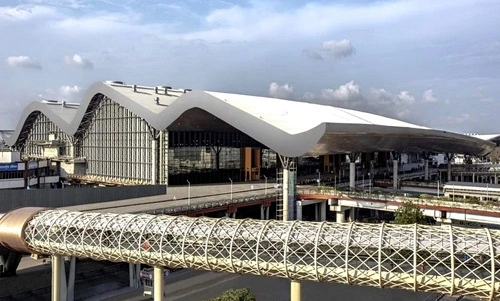India’s aviation sector is one of the fastest-growing in the world, reflecting the country’s increasing connectivity, tourism, and economic progress. Airports across the nation have seen record-breaking passenger numbers due to a surge in domestic and international travel post-pandemic. The UDAN (Ude Desh Ka Aam Nagrik) scheme is also a great initiative that has made air travel affordable for many people. In the last eight years, more than 600 flights have been started under this scheme. As of 2024, India’s busiest airports serve as vital transport hubs, connecting millions of travelers to destinations worldwide. Below is a detailed list of the top 10 busiest airports in India, highlighting their achievements and significance.
1. Indira Gandhi International Airport, Delhi (IATA: DEL)

Passenger Traffic: Approx. 73.6 million in 2023–24 (+12.8% growth).
Indira Gandhi International Airport, located in New Delhi, is India’s busiest and one of the largest airports in South Asia. It spans over 5,100 acres and serves as a hub for major airlines like Air India and Vistara. With state-of-the-art infrastructure, IGI boasts three operational runways and multiple terminals, including the expansive Terminal 3, which handles most international traffic. Plans for a fourth runway and Terminal 4 aim to further increase capacity.
2. Chhatrapati Shivaji Maharaj International Airport, Mumbai (IATA: BOM)

Passenger Traffic: Approx. 52.8 million in 2023–24 (+20.2% growth).
Mumbai’s airport is the second busiest in the country and is renowned for its iconic architecture, particularly its Terminal 2, which doubles as an art gallery showcasing Indian culture. Its strategic location makes it a crucial hub for Western India. The airport is expected to benefit from the opening of Navi Mumbai International Airport, which will ease congestion by 2024.
3. Kempegowda International Airport, Bengaluru (IATA: BLR)

Passenger Traffic: Approx. 37.5 million in 2023–24 (+17.6% growth).
Situated in the tech hub of India, Bengaluru, this airport is known for its efficiency and sustainability initiatives. It features two runways and a newly inaugurated Terminal 2, nicknamed the “Terminal in a Garden” due to its lush greenery. With increasing tech professionals and international connections, Kempegowda Airport continues to grow as a preferred hub.
4. Rajiv Gandhi International Airport, Hyderabad (IATA: HYD)

Passenger Traffic: Approx. 25 million in 2023–24 (+19.3% growth).
This airport stands out for its passenger satisfaction and world-class services. Located in Hyderabad, Telangana, it has won numerous awards for its efficient operations and eco-friendly initiatives. The ongoing expansion project, including a new terminal, is expected to double its capacity.
5. Chennai International Airport, Chennai (IATA: MAA)

Passenger Traffic: Approx. 21.2 million in 2023–24 (+14.2% growth).
The gateway to South India, Chennai Airport is a vital hub for domestic and international flights, particularly to Southeast Asia and the Middle East. Renovation of its older terminals and a new integrated terminal are underway to accommodate the growing passenger numbers.
6. Netaji Subhas Chandra Bose International Airport, Kolkata (IATA: CCU)

Passenger Traffic: Approx. 19.8 million in 2023–24 (+11.3% growth).
As Eastern India’s primary aviation hub, Kolkata’s airport has undergone significant modernization in recent years. Its modernized terminal blends tradition and technology, and the airport plays a key role in connecting India to countries like Bangladesh and Bhutan.
7. Sardar Vallabhbhai Patel International Airport, Ahmedabad (IATA: AMD)

Passenger Traffic: Approx. 11.7 million in 2023–24 (+15.4% growth).
Ahmedabad’s airport is a growing hub for Western India and serves as a gateway for business travelers and tourists exploring Gujarat. With upcoming expansions, including a new terminal, the airport aims to handle increased traffic efficiently.
8. Cochin International Airport, Kochi (IATA: COK)

Passenger Traffic: Approx. 10.4 million in 2023–24 (+17.6% growth).
Cochin International Airport is notable for being the world’s first fully solar-powered airport, setting benchmarks for sustainability. Located in Kerala, it serves as a hub for the large non-resident Indian (NRI) population traveling between the Gulf countries and India.
9. Pune Airport, Pune (IATA: PNQ)

Passenger Traffic: Approx. 9.5 million in 2023–24 (+19% growth).
Pune Airport has grown rapidly in recent years, catering to both domestic and international travelers. A new terminal building under construction will significantly enhance its capacity and improve passenger experience.
10. Dabolim Airport, Goa (IATA: GOI)

Passenger Traffic: Approx. 6.9 million in 2023–24 (-17.8% decline).
Located in Goa, Dabolim Airport remains a key gateway for tourists visiting this popular coastal state. Despite a slight dip in passenger numbers, it continues to play a vital role in the region’s tourism-driven economy. Mopa Airport, a new airport in North Goa, is expected to complement Dabolim by sharing traffic.
Future Trends and Developments
India’s aviation industry is witnessing unprecedented growth, driven by an expanding middle class, increased disposable income, and a growing preference for air travel. Government initiatives like the UDAN scheme aim to improve regional connectivity, making flying accessible to more people. Additionally, several airports are undergoing expansion or modernization to handle the rising passenger demand.
Key upcoming projects include:
- The opening of Navi Mumbai International Airport, expected to ease congestion at Mumbai Airport.
- Expansion of Jewar Airport near Delhi, which will eventually become one of the largest airports in the world.
Conclusion
India’s busiest airports are more than just transport hubs; they are symbols of the country’s progress and global connectivity. From state-of-the-art infrastructure to sustainability initiatives, these airports showcase India’s aspirations to become a leading player in the global aviation industry. As passenger numbers continue to rise, the focus on enhancing capacity and improving passenger experiences will remain pivotal in shaping the future of air travel in India.

